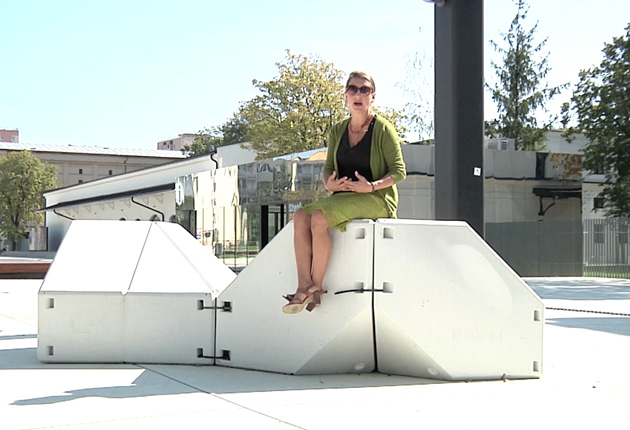Artistic Interventions
Pia Areblad
The role of the producer is to understand the driving force of the artist, understand the change sin society, understand the needs of companies and opportunities how to collaborate, and based on that find artists that want to engage in situations in companies, match them, find funding, and support the process. When I say support the process, this is a strong process; we coach the artists at least once every month, we have project meetings in-house, in the company, one meeting every month; it’s also before we start the long projects, we have had several meetings in-house, in the organisations to explain what artistic thinking is all about and how this can influence the companies and the organisations. To make them expect the unexpected—this is not a consultant, this is about exploring new ways of thinking, it’s exploring new kinds of worlds, so it’s not A B C. It could be A U Z. And this is development, and it’s about grasping something that is behind the corner and that can really make us evolve and develop.
There are always conflicts in these processes, so there is a need for strong facilitation. Based on the facilitation, we get interesting results. So a successful project could be, for example, a project we did with a petrol company where we had a choreographer and a dancer in the company for a year. The first thing she did, what we want all our artists to do, is spend two months just listening. So the challenge for the artist is to not come with his or her methods, the challenge for the company is to really dare to stay on the white page, in the open box, so to speak—to not start with the results because then you miss the innovation. If you start with the end product, then you’ll miss the journey.
So the first 2 months is to explore, and then you decide upon what areas we want to focus on. And in this project, we wanted to focus on the communication between the market administration division and the production, because there is often a gap between these divisions in companies. The people in the office and the people on the factory floor. So she did several kinds of activities to bridge over them. When an artist comes in doing this, it strengthens quite a lot the communication because she is not a consultant—she gives some free space, she moves to another space to communicate. She is not in the hierarchy, so this opens a totally new way of communicating between these areas.
So the effects were to strengthen the working climate, better communication. And then one day she went out on the factory floor, and she saw the forklift drivers running around on the factory floor. She said—you are dancing. Her way of looking at them was that they were dancing; they were moving across the factory floor, and that was a kind of choreography for her. In dialogue with these forklift drivers, they decided together that this is important, to do a forklift ballet. So it was not her idea; it grew out of their mutual understanding, the discussion together.
It ended up in the forklift ballet in-house, which of course made these people running and driving the forklifts, made their capacity visible for other people. And then they moved it out to the streets of Gothenburg. Then, they got a market aspect to it, to strengthen the brand of the company and give a strong a strong message through the media that we are a petrol company that really does new things. If you come work with us, you will explore other things. On the webpage, they had “come and meet our choreographer in residence.” I think that it’s quite daring for a petrol company to have that on their starting page. Their customers answered, “we will always buy petrol from you, because you do unusual and new things.”
Related fights
- Idea of alternative cultural spaces
- Creative Ecology around Watershed
- Continuity with the spirit of Graz
- Transformation of Liverpool’s cultural institutions
- Measuring success of cultural investments
- Testing potential to create innovations
- Non-commercial culture centre in Moscow
- We deserve more attention from the city
- Industrial heritage of Sheffield
- Music industry of Sheffield
- What is the role of culture in Estonia?
- Halle14 is a very dense art center
- 40 years of experience in TILLT
- Artistic Interventions
- Uzupis Republic
